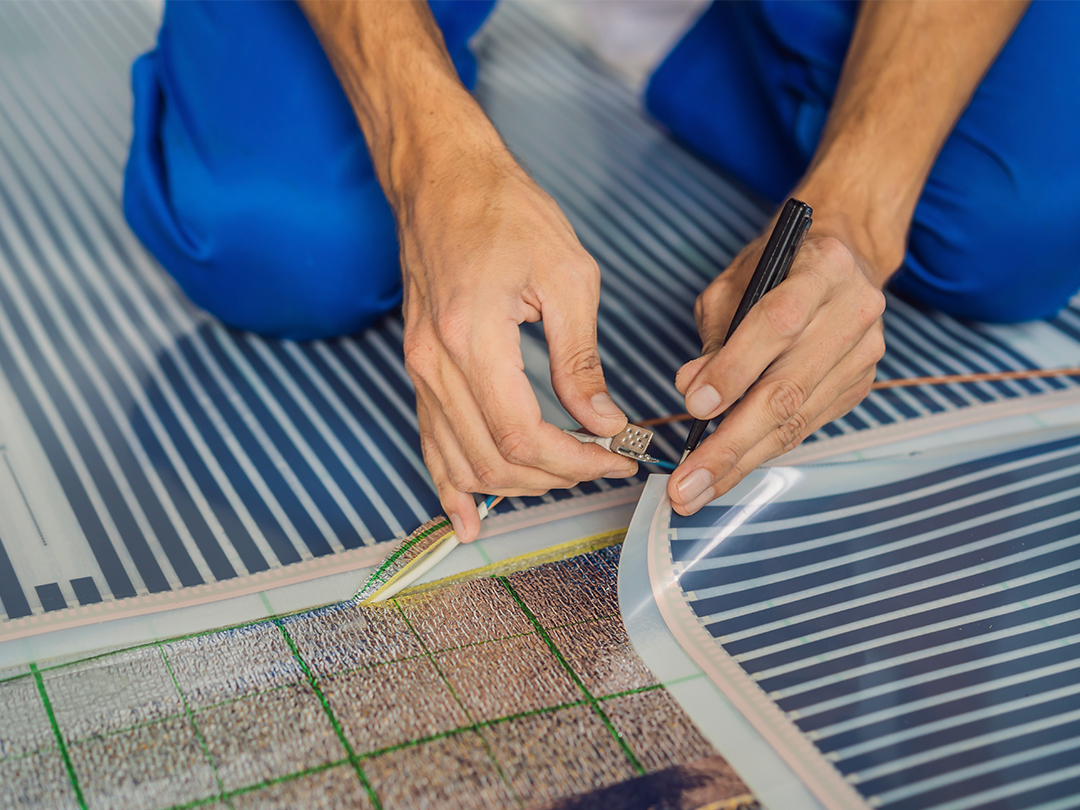ClimaLevel infrared heaters
Intensive, affordable and fast
The simple basis of direct electric or infrarot heaters is the heat generated when an electric current flows through the resistance of a heating element. Electricity generates heat because the individual electrons of a conductor collide with other atoms and begin to vibrate. These vibrations increase the kinetic energy and the temperature rises.
This effect has been used for several years with heating elements in the form of heating foils. In these, an electrically conductive coating is applied or welded to a carrier, e.g. made of polyester, and electrical current is conducted into the heating foil via connected cables and its energy is converted directly into heat. In the newly developed ClimaLevel direct heating foil, carbon nanotubes serve as surface conductors. Together with an epoxy-GFRP prepreg, they form the innovative composite material NTHX 5.0. According to studies conducted by TU Dresden, up to 98 percent of the electrical energy supplied is converted into heat in the NTHX heating foil.

ClimaLevel IR heating foil
The thin-walled heating foil made of NTHX 5.0 composite material is an inexpensive and effective panel heating system for installation in floors, walls or ceilings. The electrical connection is made to the 230 volt power supply. A controller with the appropriate switching capacity should be integrated into the power supply for demand-based control.
Wall or ceiling installation
For use as wall heating, the foils are designed for a maximum surface temperature of 50 degrees Celsius. The rough surface can be fixed to the back of the wall or ceiling with filler or tile adhesive.
Underfloor heating
Heating foils with a surface temperature limited to 35 degrees Celsius are used for underfloor heating. This means it can be laid directly on the unfinished floor and under a standard floor covering such as parquet, laminate or tiles. NTHX foil IWH35
Economic efficiency
With regard to a reliable assessment of the economic viability or amortization of a measure, the question arises as to what extent it is even possible to make forecasts regarding the development of energy prices today. Added to this is the unpredictable half-life of legal requirements. This is why infrared heaters are currently an almost unbeatably affordable solution.




Infrared heating panels
In the heating panels, the NTHX heating foil forms the core of the radiator. The film is embedded in thermal insulation on the rear side. The heat-dissipating front side has a fully mineral surface coating, is highly abrasion-resistant and solvent-resistant. The radiators mainly emit their heat in the form of radiation and convection.
Due to the radiation properties of the surface and its temperature, radiators emit heat radiation. Part of the radiated heat energy is returned from the surroundings with a lower intensity. All surfaces that are warmer than the surrounding air heat the adjacent layers of air, causing them to rise. This leads to warm air convection and describes the convective part of the heat output of a radiator.
Infrared radiant heaters heat quickly and particularly efficiently if they have a very high radiation efficiency. The radiation efficiency is the ratio of the effective radiant power emitted into the room from the front of the heating panel in relation to the electrical power supplied. According to DIN EN IEC 60675-3, radiators with radiation efficiencies below 40 percent are not considered to be
Infrared radiant heating. The ClimaLevel AWH heating panel is designed for a max. surface temperature of 90 degrees Celsius. According to measurements by an independent institute, the radiation efficiency of this design is more than 60 percent.
Possible applications for infrared heating panels
Infrared heaters are inexpensive to purchase, react extremely quickly and can be positioned flexibly. They are ideal for rooms or areas that need to be heated temporarily and for projects with their own power generation (photovoltaics). They can also be used to cover peak loads in old buildings in order to relieve the DHW heating system or reduce its VL temperature in the peak load range.
